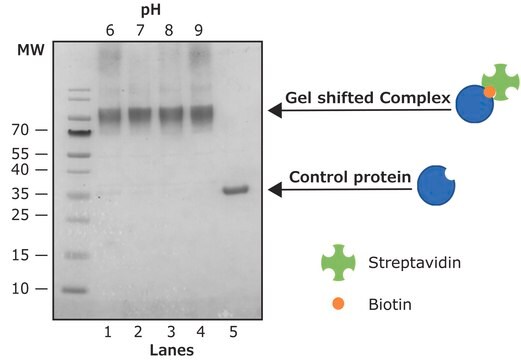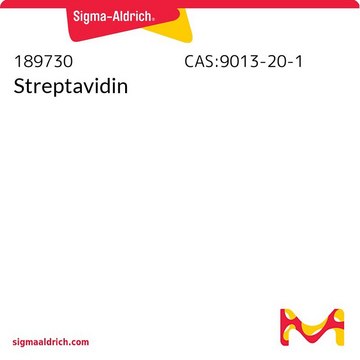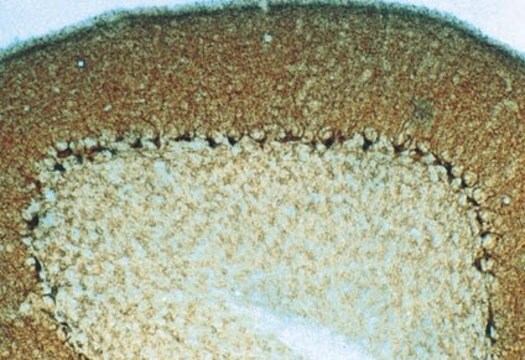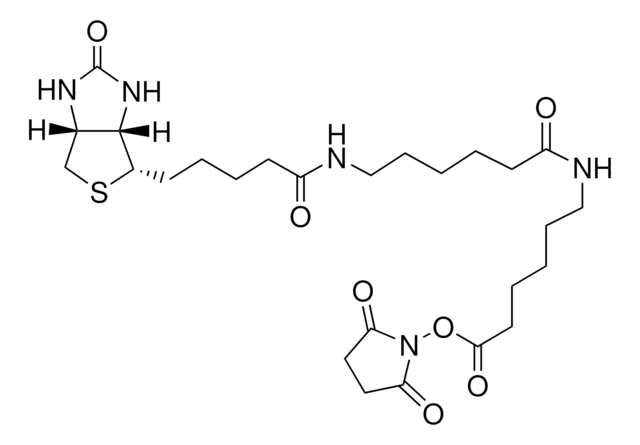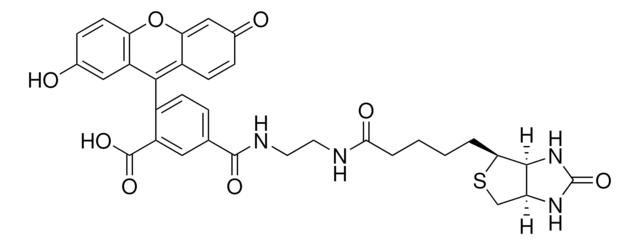Wszystkie zdjęcia(1)
Kluczowe dokumenty
BK101
ImmunoProbe™ Biotinylation Kit
Synonim(y):
Biotinylation Kits
Zaloguj sięWyświetlanie cen organizacyjnych i kontraktowych
About This Item
Kod UNSPSC:
41116134
eCl@ss:
34058011
NACRES:
NA.32
Polecane produkty
temp. przechowywania
2-8°C
Poziom jakości
Szukasz podobnych produktów? Odwiedź Przewodnik dotyczący porównywania produktów
Opis ogólny
For custom biotinylation of proteins, Sigma offers kits for conjugation on two different scales. The biotin-avidin system has become popular when high sensitivity and specificity are desired. Biotin can be conjugated to antibodies, lectins, enzymes, and other proteins. The protocols in the kits have been optimized for antibodies. Avidin binds to biotin with a high affinity (Ka = 1015 M) and specificity. When conjugated to enzymes or fluorochromes avidin provides a means of identifying biotinylated compounds via enzymatic conversion of substrate to form a visible product or detection of fluorescence by spectrophotometry or flow cytometry.
Zastosowanie
ImmunoProbe™ Biotinylation Kit has been used for preparation of biotin labeled antibodies.
Biotin has been modified with aminocaproate, then activated via an ester linkage with sulfo-N-hydroxysuccinimide (BAC-Sulfo-NHS). Aminocaproate provides a six-carbon spacer that reduces steric hindrance on the biotin and improves accessibility to the binding site on avidin. Sulfonation of the hydroxysuccinimide increases the polarity of the reagent, allowing it to dissolve easily in aqueous buffer. The ester provides a carbonyl carbon adjacent to a labile ester linkage as a target for primary amine side chains of accessible lysine residues, joining the biotinamidocaproate to the protein via an amide bond.
Cechy i korzyści
- Complete protocols for labeling and assay
- BAC-Sulfo-NHS is completely water soluble
- No DMF or DMSO needed
- Biotinylation occurs near neutral pH and physiological ionic strength, avoiding harsh conditions that could damage sensitive proteins
- Fast separation of conjugate from reactants using gel filtration
- 2-5 molar ratio biotin to protein in conjugate (for antibodies)
1 mg protein per reaction (B-TAG)
10 mg protein per reaction (BK-101)
• Sufficient reagents for at least 5 labelings
Opakowanie
Kit includes all reagents necessary for biotinylation and for determination of biotin/protein molar ratio.
Komentarz do analizy
Procedure:
Conjugation is performed in four easy steps:
1. Reconstitute BAC-Sulfo-NHS with Phosphate Buffer (PB).
2. Add BAC-Sulfo-NHS to protein and allow to react for 30 minutes at room temperature.
3. Separate the conjugate from the reactants on gel filtration.
4. Assay the conjugate for biotin incorporation by the avidin-HABA assay (BK-101 only). Conjugate is ready to use.
Conjugation is performed in four easy steps:
1. Reconstitute BAC-Sulfo-NHS with Phosphate Buffer (PB).
2. Add BAC-Sulfo-NHS to protein and allow to react for 30 minutes at room temperature.
3. Separate the conjugate from the reactants on gel filtration.
4. Assay the conjugate for biotin incorporation by the avidin-HABA assay (BK-101 only). Conjugate is ready to use.
Informacje prawne
ImmunoProbe is a trademark of Sigma-Aldrich Co. LLC
Ta strona może zawierać tekst przetłumaczony maszynowo.
Hasło ostrzegawcze
Danger
Zwroty wskazujące rodzaj zagrożenia
Zwroty wskazujące środki ostrożności
Klasyfikacja zagrożeń
Eye Irrit. 2 - Resp. Sens. 1 - Skin Irrit. 2 - STOT SE 3
Organy docelowe
Respiratory system
Kod klasy składowania
10 - Combustible liquids
Certyfikaty analizy (CoA)
Poszukaj Certyfikaty analizy (CoA), wpisując numer partii/serii produktów. Numery serii i partii można znaleźć na etykiecie produktu po słowach „seria” lub „partia”.
Masz już ten produkt?
Dokumenty związane z niedawno zakupionymi produktami zostały zamieszczone w Bibliotece dokumentów.
Klienci oglądali również te produkty
Does the Sauerbrey equation hold true for binding of peptides and globular proteins to a QCM?: A systematic study of mass dependence of peptide and protein binding with a piezoelectric sensor.
Sohna JES and Cooper MA
Sensing and Bio-Sensing Research, 11, 71-77 (2016)
Establishment of a new immunological method for direct detection of Mycobacterium in solution
Hamzehlou S and Farajollahi MM
Journal of microbiology, immunology, and infection = Wei mian yu gan ran za zhi, 49(1), 97-103 (2016)
B Viart et al.
Bioinformatics (Oxford, England), 32(10), 1462-1470 (2016-01-21)
Antibodies are an important class of biological drugs, but with limitations, such as inadequate pharmacokinetics, adverse immunogenicity and high production costs. Synthetic peptides for the desired target represent an important alternative to antibodies. However, no computational tool exists to guide
Mixed self-assembled monolayer (mSAM) based impedimetric immunosensors for cardiac troponin I (cTnI) and soluble lectin-like oxidized low-density lipoprotein receptor-1 (sLOX-1)
Billah MDM, et al.
Sensors and Actuators B, Chemical, 173, 361-366 (2012)
Hao Chang et al.
Proceedings of the National Academy of Sciences of the United States of America, 109(12), 4455-4460 (2012-03-01)
Reversibly switchable fluorescent proteins (RSFPs) have attracted widespread interest for emerging techniques including repeated tracking of protein behavior and superresolution microscopy. Among the limited number of RSFPs available, only Dronpa is widely employed for most cell biology applications due to
Nasz zespół naukowców ma doświadczenie we wszystkich obszarach badań, w tym w naukach przyrodniczych, materiałoznawstwie, syntezie chemicznej, chromatografii, analityce i wielu innych dziedzinach.
Skontaktuj się z zespołem ds. pomocy technicznej
